本文已被:浏览 1077次 下载 1427次
Received:August 19, 2019 Revised:September 06, 2019
Received:August 19, 2019 Revised:September 06, 2019
中文摘要: 为了解决密度峰值聚类算法(Density Peaks Clustering algorithm,DPC)设置截止距离和选择聚类中心过程中的问题,一种新的自调节步长果蝇优化算法被用于密度峰值聚类的重要参数截止距离的计算,设计了一种自适应选择聚类中心的方法.在截止距离计算过程中,根据迭代过程中每一步之间的最优浓度与最差浓度的差值变化率动态的调节寻优步长,其寻优效率与精度均优于现存的改进果蝇算法.在聚类中心的选择过程中,由局部密度与距离乘积的分布情况,自适应的选择聚类中心.本文提出的自调节步长果蝇优化的自适应密度峰值聚类算法的计算精度和效率均优于现存的密度峰值聚类改进算法,并能完全自适应的实现数据的聚类.
Abstract:In order to solve the problem of setting cut-off distance and selecting clustering center in Density Peak Clustering algorithm (DPC), a new self-adjusting step-size fruit fly optimization algorithm is used to calculate the cut-off distance and the important parameters in density peak clustering, an adaptive method for selecting clustering centers is designed. In the cut-off distance calculation process, the search step-size is dynamically adjusted according to the rate of change of the difference between the optimal concentration and the worst concentration in each step of the iterative process, and its optimization efficiency and accuracy are better than the existing improved fruit fly algorithm. In the selection process of clustering center, the clustering center is selected adaptively according to the distribution of the product of local density and distance. The computational accuracy and efficiency of the proposed algorithm are both better than the existing improved DPC algorithm, and it can realize data clustering completely adaptively.
keywords: clustering Density Peak Clustering (DPC) fruit fly optimization self-adjusting step-size adaptive
文章编号: 中图分类号: 文献标志码:
基金项目:国家自然科学基金面上项目(51978071);中央高校基本科研业务费专项资金(300102249301,300102249306)
引用文本:
邓然然,李伟,杨荣新.自调节步长果蝇优化的自适应密度峰值聚类.计算机系统应用,2020,29(4):126-136
DENG Ran-Ran,LI Wei,YANG Rong-Xin.Adaptive Density Peak Clustering Based on Fruit Fly Optimization of Self-Adjusting Step-Size.COMPUTER SYSTEMS APPLICATIONS,2020,29(4):126-136
邓然然,李伟,杨荣新.自调节步长果蝇优化的自适应密度峰值聚类.计算机系统应用,2020,29(4):126-136
DENG Ran-Ran,LI Wei,YANG Rong-Xin.Adaptive Density Peak Clustering Based on Fruit Fly Optimization of Self-Adjusting Step-Size.COMPUTER SYSTEMS APPLICATIONS,2020,29(4):126-136


